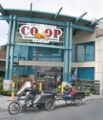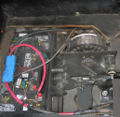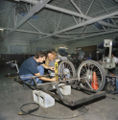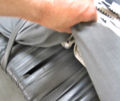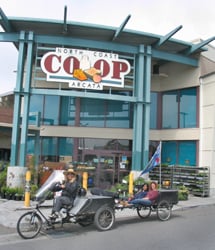
In 1990 Bart Orlando took the propane powered chevy 350 engine out of his motorhome, parked it in Arcata and purchased a 10 speed Motobecane (Translation - motorized bicycle!) from the Arcata recycling centers bike refurbishing shop staffed by Bob Orneles. The bike was being sold as part of a fund raiser for the 100th Monkey Project, organized by Rick Springer. The $100.00 used to purchase the bike went towards covering the expences for the organizations trip to a protest at a nuclear weapons testing range located in Nevada on Shoshone Native Land. While in Nevada, Rick decided to pay a visit to The American Broadcasters Award Ceremony taking place in Las Vegas. At the climax of the event, a large glass sculpture of an American Bald Eagle was presented to Ronald Reagan. It was at that moment that Rick walked on stage, brushed passed Ronnie exclaiming..... EXCUSE ME... MR. PRESIDENT !..... picked up the glass eagle and threw it to the floor, smashing it to pieces. Rick reached the podium, took a deep breath, raised the index finger of his right hand as if to make a moral point. However, before he could utter a single syllable in protest of nuclear weapons testing, he was tackled by secret service agents. A photo of Rick Springer at the podium, index finger pointing high in the air, his first syllable just taking shape, appeared on the front page of every major U.S. newspaper. As for Bob Ornelas, he went on to become the mayor of Arcata. In 1993 Bart out fitted his bike with a pedal powered electric generator and used it to power the PA system for a speech by the late David Brower at HSU. The event was organized by CCAT. and marked the beginning of his "volun-ten-year" at that facility.
For 15 years Bart has gradually improved the design of his vehicle while using it for transportation on a daily basis. Bart Commutes 8 miles from McKinleyville to Arcata where he shops at the Arcata Co-op, volunteers at CCAT and the Library Bike Center. Commuting between adjacent cities demonstrates that this vehicle is more than adequate for running errands around town. His commute along the emergency lane of the 101 freeway requires crossing the Mad River Bridge. This four lane bridge only provides a very narrow bike lane less than one foot wide. Cars traveling at speeds exceeding 65 mph pass dangerously close to bicyclists, some of whom become panic stricken and freeze up, unable to continue. Bart critical masses the slow lane of the bridge, claiming the right of bicyclists to be there and focusing attention on the fact that the Mad River Bridge should be retrofitted with safer bike lanes! His current critical mass record is 35 cars, a big-rig truck, a logging truck, a dump truck and a U-HAUL van, all following behind him at 20mph for the length of the bridge. Bart's bike is a prototype. Properly founded, such a vehicle could be built out of light weight material, equipped with light wieght lithium-ion batteries and an onboard solar array. Ken Beidelman of the Arcata Kinetic Sculpture Lab and John Davis of Arcata Electric Car provided a great deal of assistance in the fabrication of this vehicle.
-
The original Motobecane 10 speed with garden cart trailer in 1994. The trailer was motor driven using a 12v starter motor, a single 80ah marine battery and a dead man switch.
-
This photo was taken in 2004. The original bike and trailer has evolved into a 30 speed hybrid-electric tike and passenger trailer with regenerative breaking. It is capable of cruising at 20mph with assistance from the electric motor. The next step will be to add a rain/shade canopy with solar cells on top. The Canopy will shelter the full length and width of the trike and trailer. The Top layer of the canopy will be an amorphous-thin film-photovoltaic fabric. The underside of the canopy will be lined with a reflective fabric or mylar. The shape of the canopy will be a deep-focus parabolic trough with 1/2 of a transparent parabolic dome on the front and also on the back. After arriving at a destination under solar power, the canopy could then be rotated upside down so that the concave surface faces up towards the sun. At that point the canopy will be ready to function as a solar cooker with two focal points (one in front and one in back). The long trough section will also focus sunlight along a black pipe though which water is heated as it circulated to a 5 gallon hot water tank located under the "pull-lounger". The heat from the tank will rise, warming a person sleeping their on a cold night. The hot water will also be used for washing and bathing. Another planned addition to the trailer will be a pedal powered generator which a passenger can use to help charge the on board battery bank.
-
The voltage meters are each wired to one of the three marine batteries which are wired in series to provide 36v to the speed controller, motor and 12v accessory converter. Notice that the battery voltage reading on the left meter is less than the other two. Batteries wired in series do not always charge and discharge at the same rate. Unless an auxiliary 12v charger is used to boost that battery's voltage, the difference in voltage between it and the other two batteries will increase. This is because the battery with the lower voltage must pump out more amps to provide the same power. This causes the battery to discharge at a higher rate which intern lowers the voltage of that battery. When charging, (with the other two batteries at 36v), that battery won't reach full charge when the other two do.
-
The 36v battery bank with three 12v marine batteries wired in series. The batteries can be charged up by an on-board 36v - 600 watt charger that plugs into a standard 110v wall outlet. On sunny days, the batteries can be charged with solar panels. Bart has solar panels located at his residence and set up to charge the batteries at his most frequented destinations. One day, thin-film photovoltaic cells will be mounted on the trike and trailer as part of an overhead canopy. The regenerative braking system harnesses the force of gravity on down hill grades to charge the batteries by utilizing the motor as an electric generator. Energy of momentum is conserved by the regen. system whenever braking occurs...ie.....stop signs etc. The batteries sometimes charge unevenly and so each battery is wired to a female outlet into which an auxilery 12v charger is pluged in to iicrease the rate at which the battery with the lowest voltage charges.
-
The crank ring assembly
-
The transmission which connects the pedal powered chain drive from the bike front end to the differential on the rear axle of the trike frame. It sits where the rear wheel hub of the Motobecane 10 speed would be. The bike can be disconnected from the trike frame and a rear wheel can be substituted for the transmission hub.
-
The front wheel and shocks
-
The trike tool and motor (cargo) compartment. The motor is located under the center brown box. The compartment is a garder cart with an aluminum lid and front panel.
-
Three 12v marine batteries are wired in series to provide 36v to the 5hp lynch motor. The motor is designed to run on any voltage between 12v - 60v. Welding cable (many thin strands wound into one large cable for minimal resistance) is used to connect the batteries to the motor and speed controller.
-
The trike motor compartment with the motor, chain-drive, 4QD speed controller and 36v to 12v accessory voltage converter
-
The intermediate shaft of the motor chain drive is supported by pillow blocks and mounted on box tubing, connected to the trike frame. The shaft supports two sprockets. The large sprocket is driven by the motor and the small sprocket drives the body of the differential on the rear axle. This assembly is located, directly below the motor and under the trike cargo compartment. The sprockets on the right side are the same ones pictured in the lower right corner of the next image.
-
A close up view of system used to tension the motor chain drive. Each of the two chains are connected by an intermediate drive shaft. Each chain is suspended by two skateboard wheels, connected by springs. The tensioned side of the chain is reversed when switching from forward drive to reverse or from forward drive to regenerative breaking. This system provides for a smooth transition.
-
Jim and Bart building the trailer frame upon which the garden cart and passenger seat will be set. This work was done at the Arcata Library Bike Center.
-
The rear view of the trailer and 65,000 lumen hazard light used while critical massing the slow lane on the Mad River Bridge along the 101 Frwy.
-
The trailer hitch consists of a jeep tow hook and a used bicycle inner tube wrapped in a figure eight pattern around trailer frame.
-
The trailer's passenger seat ("THE PULL - LOUNGER") is wrapped with used bicycle inner tubes for a more comfortable ride.
-
A garden cart wheel is attached to a 3/4 inch axle. The axle is suspended on a leaf springs which are attached to the frame of the trailer. Motorcycle wheels similiar to those used on the trike would be better suited for for this purpose.
-
The trike rear wheels are modified front wheels from a motocross-dirt bike motorcycle. The disk brake calipers and rotor are also from the same type of motorcycle. The hub's 5/8" tapered bore was bored out to a 2" straight cylindrical bore on a lathe so that a cylindrical stainless steel sleeve fits between the axle and the wheel hub. This buttresses the wheel hub and allows the wheel to be cantilevered instead of being supported by a fork assembly as originally intended by the engineers who designed it. The rear wheels of the trike are also driven rather then free-wheeling as originally intended for the front wheel of a motorcycle. This was accomplished by bolting the sleve's flang to the same bolts that attach the disk rotor to the hub. The sleeve and axle are keyed together so that they spin in unison. The calipers are mounted on a strong bracket, custom fabricated for that purpose. The trike also has a set of drum brakes.
-
The 12v aoogha horn is mounted under the trike and activated by a dead-man switch near the hand grip.

